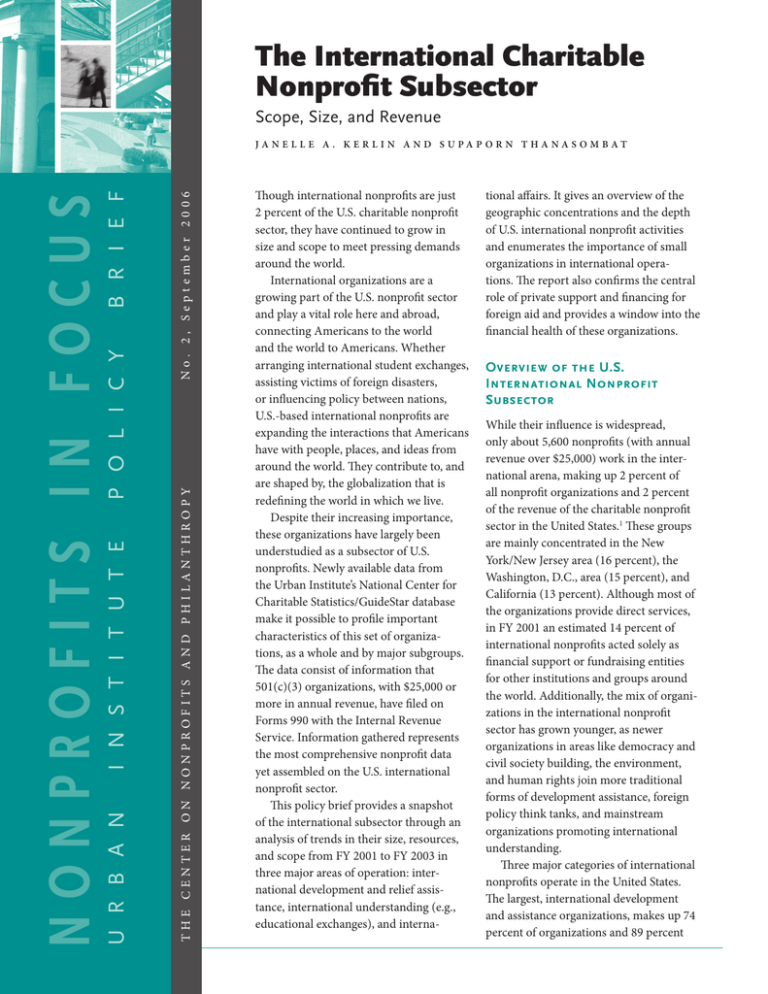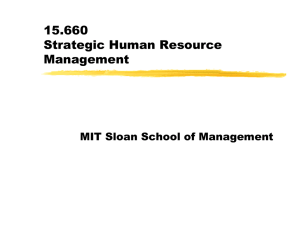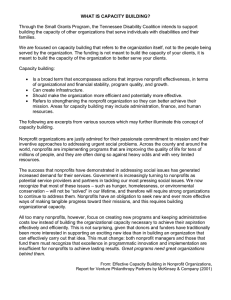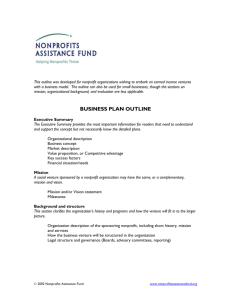The International Charitable Nonprofit Subsector Scope, Size, and Revenue
advertisement

The International Charitable Nonprofit Subsector Scope, Size, and Revenue No. 2, September 2006 THE CENTER ON NONPROFITS AND PHILANTHROPY u r b a n i n s t i t u t e p o l i c y Nonprofits in Focus b r i e f Ja n e l l e A . K e r l i n a n d S u pa p o r n T h a na s o m b at Though international nonprofits are just 2 percent of the U.S. charitable nonprofit sector, they have continued to grow in size and scope to meet pressing demands around the world. International organizations are a growing part of the U.S. nonprofit sector and play a vital role here and abroad, connecting Americans to the world and the world to Americans. Whether arranging international student exchanges, assisting victims of foreign disasters, or influencing policy between nations, U.S.-based international nonprofits are expanding the interactions that Americans have with people, places, and ideas from around the world. They contribute to, and are shaped by, the globalization that is redefining the world in which we live. Despite their increasing importance, these organizations have largely been understudied as a subsector of U.S. nonprofits. Newly available data from the Urban Institute’s National Center for Charitable Statistics/GuideStar database make it possible to profile important characteristics of this set of organizations, as a whole and by major subgroups. The data consist of information that 501(c)(3) organizations, with $25,000 or more in annual revenue, have filed on Forms 990 with the Internal Revenue Service. Information gathered represents the most comprehensive nonprofit data yet assembled on the U.S. international nonprofit sector. This policy brief provides a snapshot of the international subsector through an analysis of trends in their size, resources, and scope from FY 2001 to FY 2003 in three major areas of operation: international development and relief assistance, international understanding (e.g., educational exchanges), and interna- tional affairs. It gives an overview of the geographic concentrations and the depth of U.S. international nonprofit activities and enumerates the importance of small organizations in international operations. The report also confirms the central role of private support and financing for foreign aid and provides a window into the financial health of these organizations. Overview of the U.S. International Nonprofit Subsector While their influence is widespread, only about 5,600 nonprofits (with annual revenue over $25,000) work in the international arena, making up 2 percent of all nonprofit organizations and 2 percent of the revenue of the charitable nonprofit sector in the United States.1 These groups are mainly concentrated in the New York/New Jersey area (16 percent), the Washington, D.C., area (15 percent), and California (13 percent). Although most of the organizations provide direct services, in FY 2001 an estimated 14 percent of international nonprofits acted solely as financial support or fundraising entities for other institutions and groups around the world. Additionally, the mix of organizations in the international nonprofit sector has grown younger, as newer organizations in areas like democracy and civil society building, the environment, and human rights join more traditional forms of development assistance, foreign policy think tanks, and mainstream organizations promoting international understanding. Three major categories of international nonprofits operate in the United States. The largest, international development and assistance organizations, makes up 74 percent of organizations and 89 percent of the sector’s revenue. These organizations provide direct services to individuals, as well as technical assistance, training, and material resources to support institutional capacity building and domestic improvements in countries outside the United States. Examples include World Vision International, Physicians for Human Rights, and Freedom House. The second largest category, international understanding organizations, sponsors events and forums, conducts trainings, and facilitates exchanges to build positive relations among peoples and nations. These organizations account for a much smaller proportion of international nonprofits, making up 16 percent of the sector’s organizations and 6 percent of its revenue. Examples include Intercultural Student Exchange, Sister Cities, and the International Visitors Council of Philadelphia. The third category, international affairs, includes organizations for international affairs education, economic and trade policy, national security, and peace and arms control. This category accounts for 11 percent of the organizations and just under 5 percent of the revenue of the international nonprofit sector. Examples include the Council on Foreign Relations, the Mid-America World Trade Center Institute, Americans for Peace Now, and the United Nations Association of Greater Boston. The number of international nonprofit organizations has increased steadily, led by strong growth in the number of development and assistance Table 1 . Types of Organizations in the International Nonprofit Subsector, circa 2003 Number % of total int’l nonprofits 866 15.0 2,770,563,787 15.7 Agricultural development 65 1.0 202,131,615 1.1 Economic development 200 4.0 383,579,680 2.2 Type of nonprofit Total revenue ($) % of total revenue International development and assistance General International relief 1,200 21.0 6,412,788,171 36.2 Educational development 491 9.0 791,543,584 4.5 Health development 738 13.0 2,455,202,841 13.9 Science and technology development 53 1.0 46,948,625 0.3 Democracy and civil society development 93 2.0 251,277,539 1.4 Environment, population, and sustainability 209 4.0 1,483,349,607 8.4 Human rights, migration, and refugees 212 4.0 941,816,849 5.3 4,127 74.0 15,739,202,298 89.0 General 342 6.0 349,814,542 2.0 International cultural exchange 120 2.0 56,155,559 0.3 International academic and student exchange 263 5.0 561,544,247 3.2 International exchanges N.E.C. 161 3.0 136,662,235 0.8 886 16.0 1,104,176,583 6.3 General 165 3.0 151,034,905 0.9 Peace and arms control 205 4.0 122,172,999 0.7 International affairs education 103 2.0 486,660,673 2.7 37 1.0 44,019,940 0.2 International development and assistance subtotal International understanding International understanding subtotal International affairs National security 75 1.0 52,795,144 0.3 International affairs subtotal International economic and trade policy 585 11.0 856,683,661 4.8 Total international nonprofits 5,598 100.0 17,700,062,542 100.0 Source: National Center for Charitable Statistics/GuideStar National Nonprofit Database. N.E.C. = not elsewhere classified Note: Percentages do not add to 100 due to rounding. Table 2 . International Nonprofits with Government Grants by Size of Organization, circa 2003 Small Medium Large Less than $500,000 $500,000–$1,999,999 $2 million and above Government-funded international nonprofits # % # % # % International development and assistance 93 24 95 24 203 52 International understanding 62 49 32 25 33 26 International affairs 39 49 21 26 19 24 194 32 148 25 255 43 Total government-funded international nonprofits Source: National Center for Charitable Statistics/GuideStar National Nonprofit Database. nonprofits. Revenue has also grown, with a slight increase from FY 2001 ($15.4 billion) to FY 2002 ($15.9 billion), and a 11 percent jump in FY 2003 over FY 2002 levels to $17.7 billion. Table 1 is a snapshot of U.S. international nonprofits in our dataset for FY 2003. It indicates the number, percentage, and overall revenue of international organizations by category and subcategory. Small Organizations Are a Majority of the International Nonprofit Sector The widespread contributions of small, grassroots international organizations are often overlooked in favor of highly visible efforts by global mega-organizations in the field of development and relief. Our analysis of the U.S. international nonprofit sector reveals that 75 percent of its organizations are small, with less than $500,000 in revenue. The number of small organizations suggests the civic depth and programmic diversity of U.S. involvement with causes abroad. Located mainly on both coasts and to a smaller extent in Florida and Texas, these organizations often draw on financial resources and local support from concentrated ethnic communities to serve related areas of the world. Their predominance throughout the United States signals the increasing importance of diaspora communities in channeling small private donations to their homelands through international nonprofits. Additional inquiry into small organizations can offer a window into social capital building on an international scale, where person-toperson exchanges build goodwill and meet need. The large proportion of small nonprofits in the United States is also significant because organizational size is a factor in government grantmaking. Currently, government grants make up 20 percent of the revenue for the sector. Table 2 illustrates the percentage of international organizations with government grants by size of organization and reveals a bias towards funding larger nonprofits. While large organizations make up only 11 percent of international organizations, they make up 43 percent of those receiving government grants. Private Contributions Remain a Key Funding Source Though larger organizations may receive sizable amounts of government funding, the most significant source of funding for U.S. international nonprofits is private contributions. In FY 2003, private contributions made up 70 percent of total revenue in the sector. Indeed, a study recently released by the Hudson Institute shows that all global philanthropy and private giving from the United States, including private donations, volunteerism, public-private partnerships, and private investment, amounts to at least $71 billion per year—over three and a half times U.S. official government development aid (Hudson Institute 2006). Table 3 shows the sources of revenue as a percentage of total revenue for three main categories of the international nonprofit subsector. International affairs organizations received the highest percentage of revenue (74 percent) from private contributions. This included both direct contributions, funds raised in the name of the organization, and indirect contributions, funds received indirectly through solicitation campaigns by federated fundraising agencies. The amount of private contributions to these organizations is proportionately more than twice that of international understanding organizations (29 percent) whose funding comes largely from program service revenue, funds collected directly from recipients receiving services from the organization. Additionally, Americans’ generosity for causes beyond their borders can be measured in both the cash and non-cash private contributions. Nearly 15 percent of the organizations, primarily from the international development and assistance category, reported receiving non-cash contributions with an estimated total value of over $6 billion, or approximately one-third of total revenue for the subsector. International Nonprofits Are in Precarious Financial Health Recent scandals in the nonprofit sector have resulted in increased pressure on international organizations to limit spending on administration and direct fundraising (especially by public campaigns), leaving more funds available for programs and services (InterAction 2004). Table 4 shows the breakdown of total expenditures into program, administration, and fundraising and reveals that the vast majority of international nonprofits’ funds go to program activities. For all nonprofits shown, 89 percent of expenses reportedly go to program costs, 7 percent to administrative expenses, and 4 percent to fundraising expenses. Although expenditures seem to support high levels of program activity, some degree of caution must be exercised when examining administrative and fundraising costs reported on the IRS Form 990. Previous research (Hager, Pollak, and Wing 2004) suggests that nonprofit organizations may be keeping administrative and fundraising costs excessively low to attract private contributions and may be jeopardizing their core organizational structures and administrative capacities. Despite low levels of administrative and fundraising expenses, the international nonprofit sector operates on a slim cash margin, with annual revenues ($17.7 billion) just outpacing annual expenses ($17.2 billion) for FY 2003. Thirty-nine percent of all development and assistance organizations and forty-four percent of international understanding organizations had negative operating margins for FY 2003. The financial outlook for international affairs organizations seems especially dismal, with 47 percent operating in the red. Some of this can be attributed to the cash flow imbalances in revenue and program expenditures that most nonprofits show from year to year, which are often reconciled over two or more subsequent years (Kerlin and Reid 2005). Nonetheless, many of these nonprofits seem to be running bare-bones operations, which could result in program cuts if they fall on serious financial difficulties. Assets provide a more encouraging view of the sector’s financial health and may offset the negative operating balance that many of these organizations report. Ninety-two percent of all international nonprofit organizations report positive net assets. Nonprofits with more equity are better able to weather financial shocks. Should the need arise, they are in a better position to borrow money or convert equity and assets to cash. Interestingly, international relief organizations, a subcategory of international development and assistance, had the second lowest average net assets as a subcategory ($1.5 million). Low assets provide little cushion for organizations expected to respond quickly to large-scale disasters, often before there is time to Table 3 . Sources of Revenue by Percentage of Total Revenue for Three Main Categories of International Nonprofits, circa 2003 Percentage N Type of international nonprofit International development and assistance Private Government contributions grants Program services Other revenue 3,061 71 20 6 2 International understanding 666 29 25 41 5 International affairs 472 74 8 13 6 4,199 70 20 9 3 Total international nonprofits Source: National Center for Charitable Statistics/GuideStar National Nonprofit Database. Notes: Private contributions combine direct and indirect contributions. Other revenue includes small revenue categories such as membership dues, interest, dividends, rental income, other investment, sales of goods, and revenue from special events and activities. Additionally, those nonprofits in the database filing the 990-EZ could not be included in the analysis (990-EZ forms do not provide information on specific sources of revenue). Table 4 . Types of Expenditures by Percentage of Total Expenditures for Three Main Categories of International Nonprofits, circa 2003 Percentage N Type of international nonprofit International development and assistance Program Administration Fundraising 3,061 90 6 4 International understanding 666 85 13 2 International affairs 472 83 11 6 4,199 89 7 4 Total international organizations Source: National Center for Charitable Statistics/GuideStar National Nonprofit Database. Note: Those nonprofits in the database filing the 990-EZ could not be included in the analysis (990-EZ forms do not provide information on specific sources of revenue). obtain contributions and grants from donors. This finding underscores earlier research by the Center on International Cooperation (1999) that found most humanitarian relief organizations have inadequate reserves even though they must rely on their own funds in the immediate aftermath of a crisis. Regional Priorities Development and assistance organizations comprise the largest category of international nonprofits in the United States, providing direct services to individuals, as well as technical assistance, training, and material resources to support institutional capacity building abroad. Nearly 3 in 10 (29 percent) of all U.S. development and assistance organizations provide assistance to more than one region of the world or do not identify their work in a specific region, making it difficult to determine the exact extent of aid reaching various regions (figure 1). Nonetheless, global organizations seem to predominate in all areas of international development and aid except in the area of education, where smaller organizations prevail in single regions. The second largest concentration of U.S.-based international nonprofits works in the Latin America and Caribbean region. Many are small organizations. Examining development and assistance organizations with a single-region focus provides further insight on various types of international aid. Organizations focused on health, agriculture development, and environment and sustainability are concentrated in Latin America. Economic development nonprofits are primarily found in Latin America, Central Europe, and Central Asia. Education development organizations are most prevalent in three broad regions: Latin America and the Caribbean, South and East Asia and the Pacific, and the Middle East and North Africa. Twenty-eight percent of U.S. international nonprofit organizations focused on democracy and civil society are found in Central Europe and Central Asia, though this figure is down slightly from 2001 levels (when democracy and civil society objectives shifted to the Middle East and Asia). F igure 1 . International Development and Assistance Nonprofits by Region of Operation, circa 2003 Source: National Center for Charitable Statistics/GuideStar National Western Europe, Canada, Australia, New Zealand, Japan The Middle East and North Africa Central Europe and Central Asia 8% 10% 3% Global (more than one region) 29% 11% Sub-Saharan Africa 15% South and East Asia and the Pacific Nonprofit Database. 24% Latin America and the Caribbean Conclusion Though international nonprofits are just 2 percent of the U.S. charitable nonprofit sector, they have continued to grow in size and scope to meet pressing demands around the world. They mobilize 2 percent of total U.S. nonprofit sector revenue in three major areas of operation: international development and assistance, promotion of international understanding, and international affairs. The high percentage of small organizations in the international nonprofit sector reveals the depth of its civic support and programmatic diversity. Largely funded by cash and non-cash private contributions with smaller but significant funding from government, international nonprofits report that the vast majority of their funds go to programs and services. There are signs, however, of some financial vulnerability in this sector. A sizable percentage show slim cash margins each year, but the high percentage of organizations with positive net assets may counterbalance this picture of financial distress. Overall, these organizations have a farreaching impact in various regions of the world, especially through their largest category of activity, international and development assistance nonprofits. For More Information A complete review of data from the National Center for Charitable Statistics/GuideStar database can be found in the report The International Charitable Nonprofit Subsector in the United States, available on the Urban Institute web site at http://www.urban.org/url.cfm?ID=411276. organizations with revenue below $25,000 and many religious nonprofit organizations (regardless of revenue size) because they are exempt from filing IRS Form 990. Only organizations that filed Form 990 (as opposed to Form 990-EZ) are considered; the 990-EZ does not provide a separate line for government grant revenue. References Center on International Cooperation. 1999. The Preparedness Challenge in Humanitarian Assistance. New York: Center on International Cooperation. Hager, Mark, Thomas Pollak, and Kennard Wing. 2004. “Getting What We Pay For: Low Overhead Limits Nonprofit Effectiveness.” Washington, DC: The Urban Institute. Center on Nonprofits and Philanthropy and Indiana University Center on Philanthropy. Overhead Cost Project Research Brief No. 3. Hudson Institute. 2006. The Index of Global Philanthropy 2006. Washington, DC: Hudson Institute. http://www. global~prosperity.org. InterAction. 2004. Nongovernmental Organizations in Overseas Assistance. Occasional Paper, September 2004. Washington, DC: InterAction. Kerlin, Janelle A. 2006. “U.S. Government Funding for International Nongovernmental Organizations.” Washington, DC: The Urban Institute. Center on Nonprofits and Philanthropy. Nonprofits in Focus Policy Brief No. 1. Kerlin, Janelle, and Elizabeth J. Reid. 2005. “Federal Policy Shifts and Nonprofits: Foreign Policy Change and its Effect on U.S. International NGOs.” Paper presented for the 34th Annual ARNOVA Conference, Washington, DC, November 17–19. Reid, Elizabeth, and Janelle Kerlin. 2006. The International Charitable Nonprofit Subsector in the United States: International Understanding, International Development and Assistance, and International Affairs. Washington, DC: The Urban Institute. Center on Nonprofits and Philanthropy. Research Report. Note 1 Nonprofit sector generally refers to all formally organized U.S. tax-exempt organizations, though the data used in this study are limited to charitable tax-exempt organizations, that is, 501(c)3 organizations. International nonprofit subsector refers to U.S.-based charitable organizations whose primary purpose or mission is international in scope. The dataset itself does not include Acknowledgments The authors would like to thank Elizabeth Reid for her many contributions in the development of this policy brief. Kendall Golladay and Kanisha Bond also provided invaluable assistance with data analysis and classification of organizations. About the Authors Janelle A. Kerlin is a research associate in the Center on Nonprofits and Philanthropy at the Urban Institute, where she conducts research on politics and policy related to nonprofit development and operation. She is coauthor of the report U.S. Government Funding for International Nongovernmental Organizations, and has authored a book chapter and several conference papers on international organizations. Dr. Kerlin holds an M.S. from Columbia University and a Ph.D. in political science from the Maxwell School at Syracuse University. Supaporn Thanasombat is an emerging scholar in the Center on Nonprofits and Philanthropy at the Urban Institute and a master of public policy student at the University of Michigan’s Gerald R. Ford School of Public Policy, focusing her degree on public and nonprofit management and international policy. She is a recipient of the 2006 Foreign Language and Area Studies Fellowship and is a 2002 Public Policy and Interna-tional Affairs fellow at the Richard and Rhoda Goldman School of Public Policy. She holds a B.A. in Develop-ment Studies with a minor in City and Regional Planning from the University of California–Berkeley. THE URBAN INSTITUTE 2100 M Street, N.W. Washington, D.C. 20037 Nonprofit Org. U.S. Postage PAID Permit No. 8098 Mt. Airy, MD Phone: 202-833-7200 Fax: 202-467-5775 http://www.urban.org IN THIS ISSUE nonprofits in focus The International Charitable Nonprofit Subsector Scope, Size, and Revenue For more information, call Public Affairs at 202-261-5709 or visit our web site, http://www.urban.org. To order additional copies of this publication, call 202-261-5687 or 877-UIPRESS, or visit our online bookstore, http://www.uipress.org. nonprofits in focus The views expressed here are those of the authors and do not necessarily reflect those of the Urban Institute, its board, its sponsors, or other authors in the series. The Urban Institute’s Center on Nonprofits and Philanthropy conducts research on the nonprofit sector to inform decisionmakers in government, nonprofits, foundations, and business. Our mission is to create an objective picture of the nonprofit sector, advance transparency and accountability, and assess consequences of public policies on the sector through rigorous research. We facilitate dialogue on pressing issues by hosting policy briefings and by disseminating findings widely. Our publications are available on the Urban Institute web site, at http://www.urban.org/center/cnp/. Through the National Center for Charitable Statistics (NCCS) we create and maintain the National Nonprofit Data System, a research-quality datasource on the nonprofit sector. NCCS translates data on the sector’s size, scope, and financial trends into accessible information for local, state, and national policymakers and provides data and technical assistance to scholars and the public. NCCS databases can be accessed at http://www.nccs.urban.org. permission is granted for reproduction of this document with Copyright ©2006 attribution to the urban institute.





